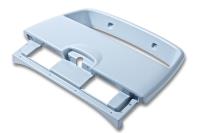 Add My Company
Add My Company
Sign In
How Does Pressure Forming Work?
05-05-2022

How Does Pressure Forming Work
Posted by:AdminTags:Posted date:05-05-2022
How Does Pressure Forming Work
This article asks: how does pressure forming work? If you have a pressure forming project that you are considering, we look at what pressure forming is and how it can benefit your needs.
What Is Pressure Forming?
Pressure forming processes are a form of plastic thermoplastic, creating various detailed, crisp, alternative design features and intricate textures.
In the same way, it is almost like injection moulding; however, its production and tooling methods are much faster and more straightforward altogether. You can create incredible, useful plastic products at a fraction of the costs, so it's best to select the process method based on your budget and industrial requirements.
How Does Pressure Forming Work?
Pressure forming is relatively similar to conventional vacuum forming processes in the sense that materials are formulated by utilising contoured surfaces. Professional engineers will use vacuum pressure to draw the desired material against the mould skilfully.
You can modify the forming diagnostic equipment and tooling to apply significant positive air pressure to the surface against specific plastic parts you wish to create. There will be a dramatic increase in the level of pressure applied so that you can curate more accurate details on its surface area before the final assembly.
Why Use Pressure Forming?
Pressure thermoforming is a manufacturing technique for plastic thermoforming, as a broader term of the process. Professionals will heat 2-dimensional thermoplastic sheets to their highest, optimal pressure-forming temperature. Next, it is placed carefully over a custom tool or mould.
They will apply a positive pressure box onto the heated sheet and press the material onto the surface of the mould to bear the weight, creating specific 3-dimensional shapes onto the heated plastic.
Once the moulded parts harden and cool down, it is removed and further processed according to its specification to create finished parts.
They can produce crisper, more detailed features; however, its process is much more straightforward in comparison to others, creating plastic products for cheaper.
HIGH DEGREE OF SURFACE DETAIL
DESIGN AESTHETICS AND BRANDING CAPABILITIES
LARGE PART CAPABILITY AT A LOW COST
LIGHTWEIGHT MATERIAL BENEFITS
RUGGED AND INDUSTRY COMPLIANT MATERIAL PERFORMANCE
LOW TOOLING INVESTMENT
MULTI-PART ASSEMBLIES AND PROJECTS
MODERATE ANNUAL VOLUMES (250-5000)
RAPID PRODUCT DEVELOPMENT
Typical Applications Of Pressure Forming
Pressure thermoforming is cost-effective and incredibly versatile, making it suitable for various industrial applications. Pressure thermoformed parts are typically utilised for replacements of any components made of fabricated sheet metal.
They provide us with various unique benefits, especially where manufacturing processes like Fiber-Reinforced Plastics (FRP) and Resin Transfer Moulded (RTM) are concerned.
No matter if your project is a brand-new design or a conversion of one process to another, we highly recommend investing in pressure-forming for all productive plastics components as it is an ideal solution for a range of vast industries and applications.
For example, it is perfect for the following:
Enclosures and Fascias for ATMs, POS applications and Kiosks
Interior parts of railcars, for example, panelling, tray tables, trimming, window masks, luggage racks, seating and many more
Medical device equipment storage and enclosures
Panelling and interior/exterior covers for any construction or industrial handling vehicles
Components suitable for foodservice
Material handling components and various handling trays
Bedliners fit for pick-up trucks
Wastewater management components
Components for portable toilets
Enclosures for large equipment
Agricultural-related vehicles or equipment
Vacuum Forming vs Pressure Forming
Compared to straight vacuum forming, which is the most popular two processes and tends to work best on simplistic products that don't need any specific detail, pressure forming is often the best choice for thermoforming.
Pressure forming fits best when the aesthetics of a product are one of the essential factors to consider during its transportation.
Pressure forming is an incredibly cost-efficient substitute that allows you to produce plastic compartments with sharper features and more crisp details than other vacuum formed methods.
Pressure forming plastic is fantastic and can be utilised to conceal a whole host of products, including:
Panels, final parts, and enclosures require precise surface cosmetics and sharp corners to conceal their shape
Fronts and bezels that need immense durability
Exterior panels that are appealing but require openings suitable for controls and gauges
Three-dimensional enclosures and housings are commonly used in medical equipment for offices, commercial, and electrical devices
Covers, hatches, doors and movable panels that are user-facing and require plenty of durabilities, attractive exterior finish and sharp details.
The pressure forming process is relatively unique compared to traditional vacuum forming and offers many advantages that it simply cannot.
Customers should involve themselves in the design and engineering aspects, especially if they require pressure-formed parts and be part of the tooling production process that it requires. Understanding the design limitations can help each end-user, and the thermoformer achieve product packaging satisfaction.
Are you looking for Pressure Forming or Vacuum Forming services in the UK? Follow the link below to find out more about our bespoke services.
For more information on How Does Pressure Forming Work? talk to Plastics By Design Ltd
Enquire Now
List your company on FindTheNeedle.

